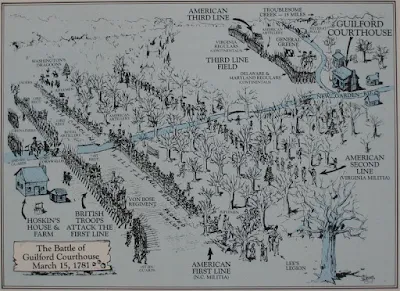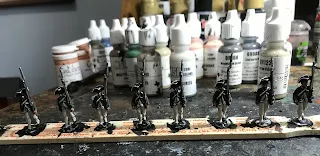Guilford Courthouse 15 March 1781
Along the first line:
" As at Camden, the British went forward as soon as they were in line. Captain Peter led the 23rd on as acting commanding officer, with the regiment effectively in two wings under captains Saumarez and Champagne. As they went forward, one of them noticed the ‘field lately ploughed, which was wet and muddy from the rains which had recently fallen’.
On they trudged towards the fence that marked the end of Hoskins’ cornfield and the beginning of the woods to the fore, observing as they grew closer that the rails were lined with men. MacLeod’s cannon opened fire, sending their ball whooshing into the American lines. Colonel Webster, on horseback, trotted to the front of his brigade and called out so that all could hear, ‘Charge!’ The men began jogging forward, bayonets fixed and muskets levelled towards the enemy. A crackling fire from their left, Kirkwood’s riflemen, began knocking down a redcoat here or there, but did nothing to check their impetus.
When the British line was little more than 50 yards from the North Carolina militia everything seemed to stop for Serjeant Lamb: … it was perceived the whole of their force had their arms presented, and resting on a rail fence … they were taking aim with the nicest precision. At this awful period a general pause took place; both parties surveyed each other for the moment with the most anxious suspense … Colonel Webster spurred his horse to the head of the 23rd and bellowed out, ‘Come on my brave Fusiliers!’ Some of the Americans started to run, but most held on for a moment; there was a rippling crash of American musketry when the redcoats were at optimum range, 40 to 50 yards away. Dozens of Webster’s men went down as the musket balls cut legs from under them or smashed into their chests. Lieutenant Calvert worried for an instant how his men might react to such a heavy fire: ‘They instantly returned it and did not give the enemy time to repeat their fire but rushed on them with bayonets.’ Captain Saumarez noted with pride, ‘No troops could behave better than the regiment … they never returned the enemy’s fire but by word of command and marched on with the most undaunted courage.’..."
Quote from;
Fusiliers: The saga of a British Redcoat Regiment in the American Revolution by Mark Urban































